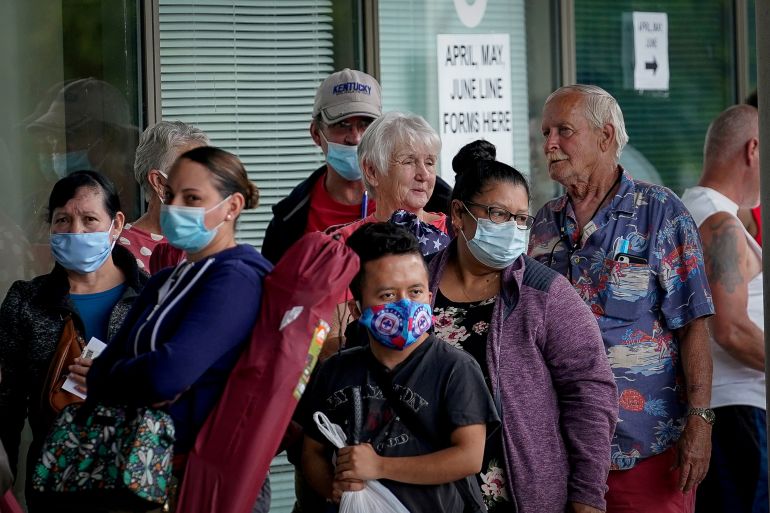US economy sheds 140,000 jobs in December in end to brutal year
The United States economy shed 140,000 jobs in December, slamming the brakes on seven months of jobs gains.

As snapshots of the United States labour market go, December’s jobs report is ugly, even by pre-pandemic standards.
The economy shed 140,000 jobs last month, the US Department of Labor said on Friday – marking a horrendous end to the most abysmal year for job losses on record.
Keep reading
list of 4 itemsA good, steady job? India election turns spotlight on a dream gone sour
Jobless engineers, MBAs: The hidden army of Indian election ‘consultants’
Will the US unemployment rate continue at historic lows?
The nation’s unemployment rate held steady at 6.7 percent, as did the number of unemployed persons – some 10.7 million workers.
December’s non-farm payroll numbers slammed the brakes on seven straight months of job gains. Taken as a whole, the data tells us what other metrics have been signalling since the end of the summer: that the US economic recovery lost steam in the fourth and final quarter of 2020.
A number of challenges have been hampering the recovery – first and foremost the return of business-sapping restrictions designed to contain spiralling COVID-19 infections.
The onset of winter has also created another barrier for struggling businesses. Both of these factors were reflected in the leisure and hospitality sector, which lost nearly half a million jobs last month.
The lapsing of federal jobless benefits at the end of July and the end of December also hobbled the recovery in the final three months of the year.
But economists are looking to several developments that could help accelerate economic growth – and crucially jobs creation later this year.
A new coronavirus relief aid package took effect on December 27. The $900bn stimulus includes a fresh financial lifeline for small businesses, extends the number of weeks that laid-off workers can claim jobless aid, and includes a $300 federal weekly top-up to state unemployment benefits.
That extra money could rev up consumer spending – the engine of the US economy, accounting for some two-thirds of growth.
And more government largesse is expected now that the Democrats have cemented control over both houses of Congress, making it easier for President-elect Joe Biden to enact key parts of his economic agenda.
Biden has said that December’s stimulus deal would not be the final one and that more generous benefits would be forthcoming to help the nation weather the pandemic.
Though the nation’s vaccination drive has proven disappointing thus far, as more people are inoculated against COVID-19, economists see the economy accelerating its march back to health.
“While these bleak numbers represent a weak handoff to 2021, the labor market recovery is expected to strengthen over the spring and summer as vaccinations lead to a gradually improving health situation,” Gregory Daco, chief US economist at Oxford Economics, wrote in a client note on Friday.
Deeper dive
A deeper dive into the jobs numbers turns up a raft of pain.
The number of people who said they couldn’t work last month or worked reduced hours because their employers had either gone under or lost business due to the pandemic rose to 15.8 million in December – one million more than the previous month.
The number of workers on temporary layoff rose by 277,000 in December to 3 million. While that is down significantly from the April high of 18 million, it is still 2.3 million higher than February’s pre-pandemic benchmark.
Average hourly earnings increased by 23 cents to $29.81. But the number reflects the disproportionate number of job losses in the lower-paid leisure and hospitality sector.
In addition to leisure and hospitality, jobs were shed in other services as well as private education and government.
One bright spot was professional and business services, which gained 161,000 jobs last month thanks to a large spike in temporary help services. Retail trade added 121,000 jobs.
The unemployment rate for whites last month ticked up slightly to 6 percent. The unemployment rate for African Americans fell to 9.9 percent. But the downward drift was driven by the number of African Americans either working or actively looking for a job – a metric known as the labour force participation rate – falling from 60.2 percent in November to 59.8 in December.